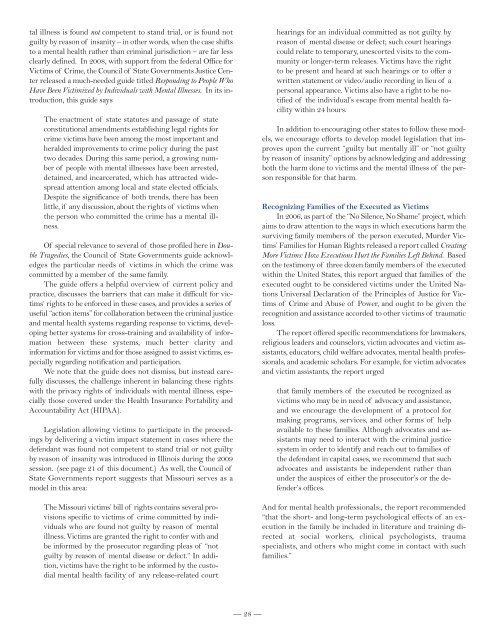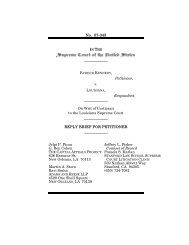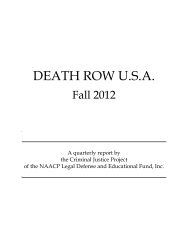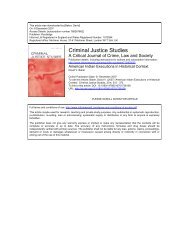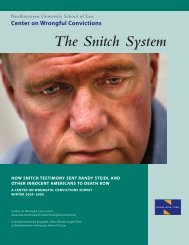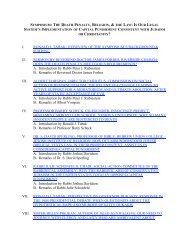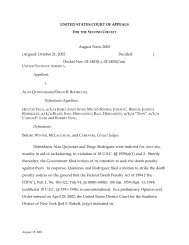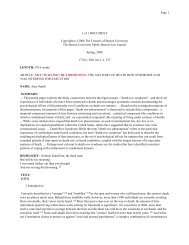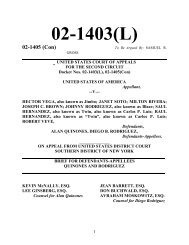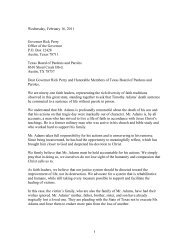Double Tragedies - Families for Human Rights
Double Tragedies - Families for Human Rights
Double Tragedies - Families for Human Rights
- No tags were found...
You also want an ePaper? Increase the reach of your titles
YUMPU automatically turns print PDFs into web optimized ePapers that Google loves.
tal illness is found not competent to stand trial, or is found notguilty by reason of insanity – in other words, when the case shiftsto a mental health rather than criminal jurisdiction – are far lessclearly defined. In 2008, with support from the federal Office <strong>for</strong>Victims of Crime, the Council of State Governments Justice Centerreleased a much-needed guide titled Responding to People WhoHave Been Victimized by Individuals with Mental Illnesses. In its introduction,this guide saysThe enactment of state statutes and passage of stateconstitutional amendments establishing legal rights <strong>for</strong>crime victims have been among the most important andheralded improvements to crime policy during the pasttwo decades. During this same period, a growing numberof people with mental illnesses have been arrested,detained, and incarcerated, which has attracted widespreadattention among local and state elected officials.Despite the significance of both trends, there has beenlittle, if any discussion, about the rights of victims whenthe person who committed the crime has a mental illness.Of special relevance to several of those profiled here in <strong>Double</strong><strong>Tragedies</strong>, the Council of State Governments guide acknowledgesthe particular needs of victims in which the crime wascommitted by a member of the same family.The guide offers a helpful overview of current policy andpractice, discusses the barriers that can make it difficult <strong>for</strong> victims’rights to be en<strong>for</strong>ced in these cases, and provides a series ofuseful “action items” <strong>for</strong> collaboration between the criminal justiceand mental health systems regarding response to victims, developingbetter systems <strong>for</strong> cross-training and availability of in<strong>for</strong>mationbetween these systems, much better clarity andin<strong>for</strong>mation <strong>for</strong> victims and <strong>for</strong> those assigned to assist victims, especiallyregarding notification and participation.We note that the guide does not dismiss, but instead carefullydiscusses, the challenge inherent in balancing these rightswith the privacy rights of individuals with mental illness, especiallythose covered under the Health Insurance Portability andAccountability Act (HIPAA).Legislation allowing victims to participate in the proceedingsby delivering a victim impact statement in cases where thedefendant was found not competent to stand trial or not guiltyby reason of insanity was introduced in Illinois during the 2009session. (see page 21 of this document.) As well, the Council ofState Governments report suggests that Missouri serves as amodel in this area:The Missouri victims’ bill of rights contains several provisionsspecific to victims of crime committed by individualswho are found not guilty by reason of mentalillness. Victims are granted the right to confer with andbe in<strong>for</strong>med by the prosecutor regarding pleas of “notguilty by reason of mental disease or defect.” In addition,victims have the right to be in<strong>for</strong>med by the custodialmental health facility of any release-related courthearings <strong>for</strong> an individual committed as not guilty byreason of mental disease or defect; such court hearingscould relate to temporary, unescorted visits to the communityor longer-term releases. Victims have the rightto be present and heard at such hearings or to offer awritten statement or video/audio recording in lieu of apersonal appearance. Victims also have a right to be notifiedof the individual’s escape from mental health facilitywithin 24 hours.In addition to encouraging other states to follow these models,we encourage ef<strong>for</strong>ts to develop model legislation that improvesupon the current “guilty but mentally ill” or “not guiltyby reason of insanity” options by acknowledging and addressingboth the harm done to victims and the mental illness of the personresponsible <strong>for</strong> that harm.Recognizing <strong>Families</strong> of the Executed as VictimsIn 2006, as part of the “No Silence, No Shame” project, whichaims to draw attention to the ways in which executions harm thesurviving family members of the person executed, Murder Victims’<strong>Families</strong> <strong>for</strong> <strong>Human</strong> <strong>Rights</strong> released a report called CreatingMore Victims: How Executions Hurt the <strong>Families</strong> Left Behind. Basedon the testimony of three dozen family members of the executedwithin the United States, this report argued that families of theexecuted ought to be considered victims under the United NationsUniversal Declaration of the Principles of Justice <strong>for</strong> Victimsof Crime and Abuse of Power, and ought to be given therecognition and assistance accorded to other victims of traumaticloss.The report offered specific recommendations <strong>for</strong> lawmakers,religious leaders and counselors, victim advocates and victim assistants,educators, child welfare advocates, mental health professionals,and academic scholars. For example, <strong>for</strong> victim advocatesand victim assistants, the report urgedthat family members of the executed be recognized asvictims who may be in need of advocacy and assistance,and we encourage the development of a protocol <strong>for</strong>making programs, services, and other <strong>for</strong>ms of helpavailable to these families. Although advocates and assistantsmay need to interact with the criminal justicesystem in order to identify and reach out to families ofthe defendant in capital cases, we recommend that suchadvocates and assistants be independent rather thanunder the auspices of either the prosecutor’s or the defender’soffices.And <strong>for</strong> mental health professionals:, the report recommended“that the short- and long-term psychological effects of an executionin the family be included in literature and training directedat social workers, clinical psychologists, traumaspecialists, and others who might come in contact with suchfamilies.”__ 28 __


